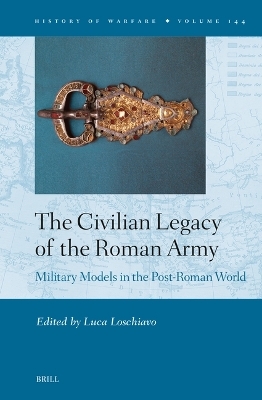
The Civilian Legacy of the Roman Army
Brill (Verlag)
978-90-04-69347-0 (ISBN)
The Roman army represented an important social and organizational reference model for the Romano-Barbarian societies, which progressively replaced the Western Empire in the transition from Late Antiquity to Early Middle Ages. The great flexibility of the decision-making and organizational solutions used by the Roman army allowed the ‘new lords’ to readapt them and thus maintain power in early medieval Europe for a long time.
From a perspective ranging from political, social and economic history to law, anthropology, and linguistic, this book demonstrates how interesting and fruitful the investigation of this specific cultural imprint can be in order to gain a better understanding of the origins of the civilization that arouse after the fall of the Roman world.
Contributors are Francesco Borri, Fabio Botta, Francesco Castagnino, Stefan Esders, Carla Falluomin, Stefano Gasparri, Wolfgang Haubrichs, Soazick Kerneis, Luca Loschiavo, Valerio Marotta, Esperanza Osaba, Walter Pohl, Jean-Pierre Poly, Pierfrancesco Porena, Iolanda Ruggiero, Andrea Trisciuoglio, Andrea A. Verardi, and Ian Wood.
Luca Loschiavo, Ph.D. (1994) is full Professor of Medieval and Modern Legal History at the University of Teramo (Italy). He has published 3 books as author (the last one is L’età del passaggio. All’alba del diritto commune europeo (secoli III – VII), 2019); 8 as coeditor; and 80 essays on medieval legal history.
Preface
List of Maps
Contributors
1 Transformation of the Military in the Late Antique West
Ian Wood
PART 1: The Words of the Soldiers
2 Hospitalitas (I.): The Munus Hospitalitatis and Its limits
Andrea Trisciuoglio
3 Hospitalitas (II.): The Changing Meaning of Hospitalitas
Pierfrancesco Porena
4 Warrior Names and Military Language of the Westgermanic Peoples: Franks and Langobards
Wolfgang Haubrichs
5 The Gothic Language of Warfare
Carla Falluomini
PART 2: Social and Juridical Structures
6 Militia and Civitas between Third and Sixth Century CE
Valerio Marotta
7 Persecuting Latrones, Maintaining Disciplina, Enforcing the Velox Supplicium: The Frankish Centena Accordind to Childebert II’s Decree
Stefan Esders
8 Soldiers’ Marriages: Before and after the Fall of the Empire
Francesco Castagnino
9 Soldiers’ Inheritance: The Testamentum Militis and other Privileges from the Imperial Constitutions to the Leges Barbarorum
Iolanda Ruggiero
PART 3: Symbols, Rituals and Identity Models
10 The Cingulum Militiae in the Early Middle Ages: Between Status and Function
Andrea A. Verardi
11 Answering the Call to Arms: Lex Visigothorum 9.2
Esperanza Osaba
12 ‘Traditionskern’, ‘Gefolgschaft’: More Questions Than Answers
Francesco Borri
13 The Lombard Army Between Myth and Reality: Farae, Arimanniae, Arimanni
Stefano Gasparri
PART 4: Geometries of the Power and Military Justice
14 Laeti and Gentiles: Military Germanic Settlements in Roman Gaul
Jean-Pierre Poly
15 Personality of Law or Ius Speciale Militum? Around the Origins of the Leges Barbarorum
Luca Loschiavo
16 Late Roman Military Justice and the Birth of Ordeal
Soazick Kerneis
17 Collective Criminal Responsibility and Comrades’ Solidarity: From Roman Military Formations to Barbarian Armed Bands
Fabio Botta
18 From the Roman Army to the Laws of the Kingdoms: Concluding Remarks
Walter Pohl
Index of Names and Subjects
| Erscheinungsdatum | 23.08.2024 |
|---|---|
| Reihe/Serie | History of Warfare ; 144 |
| Verlagsort | Leiden |
| Sprache | englisch |
| Maße | 155 x 235 mm |
| Gewicht | 1012 g |
| Themenwelt | Geschichte ► Allgemeine Geschichte ► Mittelalter |
| Geisteswissenschaften ► Geschichte ► Regional- / Ländergeschichte | |
| Geschichte ► Teilgebiete der Geschichte ► Militärgeschichte | |
| Recht / Steuern ► Rechtsgeschichte | |
| ISBN-10 | 90-04-69347-5 / 9004693475 |
| ISBN-13 | 978-90-04-69347-0 / 9789004693470 |
| Zustand | Neuware |
| Haben Sie eine Frage zum Produkt? |
aus dem Bereich


